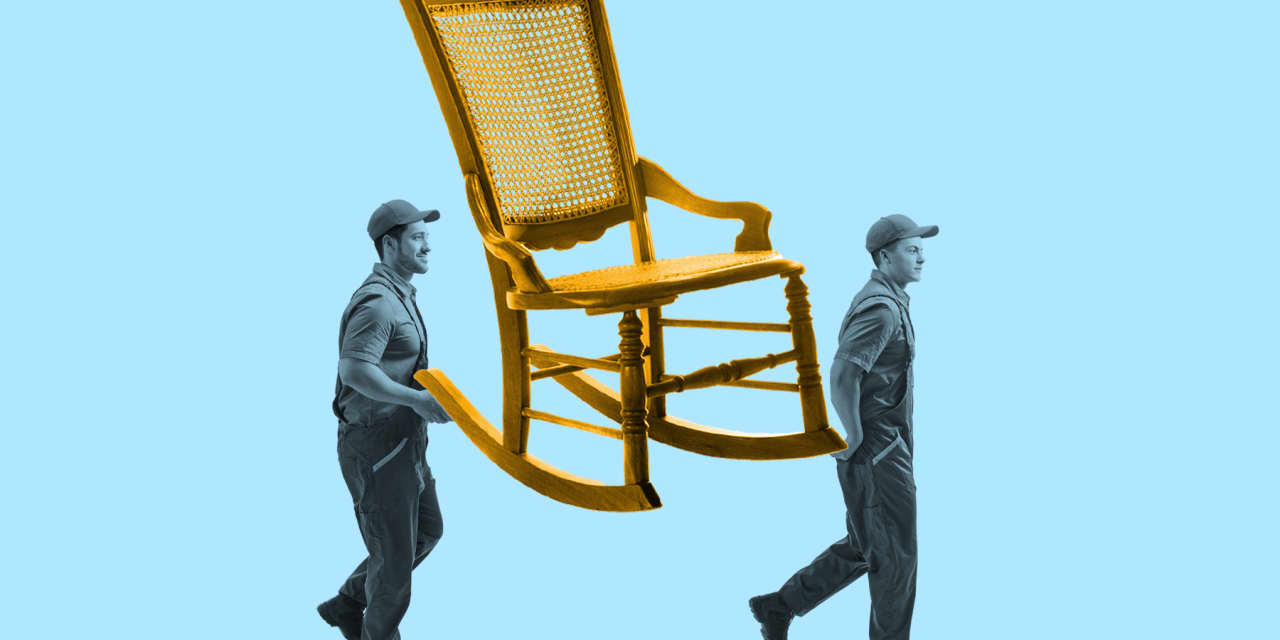When Louise Mason, 88, decided to move from a house in Boynton Beach, Fla., to an independent living facility in Boca Raton, Fla., last February, she knew she was going to need help.
“I was not physically up to this. I recognize at this age it was going to be too much for me,” Mason said. So Mason did what an increasing number of seniors are doing when they want to downsize—they hire a senior moving manager.
Specialty moving companies cater specifically to older people who need assistance with both the physically taxing part of the move—cleaning out closets, packing up boxes—as well as sifting through decades worth of stuff and deciding what to keep and what to toss.
Mason hired A Move Made Easy, a senior move manager based in Coral Springs, Fla., to help her resettle. The company handled every aspect of the move: It created a floor plan of the new space to help Mason determine what furniture she could take with her and where it would go; went through all her belongings and divvied them up into what she would sell, keep, donate, and discard; and managed all the packing, unpacking and organizing in her new apartment.
“I didn’t have to unpack boxes. I didn’t even have to make the bed. They had done everything,” said Mason, who, along with her daughter in New York, was in close contact with A Move Made Easy during the whole process.
Catering to an aging and growing population
The U.S. population aged 65 and over grew nearly five times faster than the total population from 1920 to 2020, according to the 2020 Census. The older population reached 55.8 million or 16.8% of the U.S. population in 2020. The 65-74 age group was the largest of the older age groups with 33.1 million people. And growth in the 75-to-84 age group is expected to pick up in the next decade as baby boomers age into this cohort, according to the Census.
“The first baby boomers are turning 77 this year. We’ve only started scratching the surface for family members who need this support,” said Jennifer Pickett, co-executive director of The National Association of Senior & Specialty Movers (Baby boomers are those born between 1946 and 1964.)
The trade organization started in 2002 with about 20 companies. “Our membership is now at about 1,300 companies,” said Pickett.
Because of longer life expectancies, some senior move managers say they are getting more repeat customers. “I may be moving [clients] several times,” said Sharon Cofar, owner of A Move Made Easy. “I might move them into a condo, and then independent living, and years later they call me to move them into assisted living, and after that to a skilled nursing home. And then their family calls us to stage or empty the property after their loved one passes away.”
Companies in the moving and real estate space are adapting to the demands of the senior population. “We’re seeing all sorts of different types of companies adding senior move management as a service, like interior designers, Realtors, estate sale companies,” Pickett said.
The senior movers trade group requires its member companies to carry insurance and complete courses on ethics, safety, understanding the moving industry, and contracts, liability and risk. As with any industry, seniors should be aware of potential scams. Amy Nofziger, director of fraud victim support at AARP, suggests seniors check with the Better Business Bureau if there have been complaints made against the company you are hiring, ask how it resolves disputes, and be wary of companies asking for large amounts of cash upfront.
A painful culling process
Typically, senior move managers work with traditional movers to handle the actual physical move, and have relationships with junk haulers, auction houses and other vendors that might need to be involved in the process as well. These are separate costs; moving companies charge a fee to pack boxes (if requested) and transport a client’s belongings to their new home, but that isn’t included in the hourly rate set by the senior move manager. Hourly rates range from $60 to $100 an hour, depending on where you live. Hourly rates can go up to $180 in more expensive cities like New York and San Francisco.
The process usually starts with a consultation—sometimes complimentary—that includes an estimated cost of the move. They measure the client’s new space, take a furniture inventory, and create a digital floor plan so clients can see how everything will look and figure out how much can fit. The move managers also take pictures of closets, kitchen cabinets, art on walls so movers have a sense of where their clients’ items belong in their new home. Some move managers will even help their clients submit a change of address to the Postal Service and ensure the Wi-Fi is set up in their new home.
“Most of our clients haven’t moved in 40 to 50 years,” said Katie Hustead, co-owner of Paper Moon Moves, a senior move manager in New York City. “Now they’re at a stage when they know this isn’t working. It’s hard to admit. We’re kind of holding their hand through the whole process. And the bulk of the work is downsizing—that’s where we spend most of our time.”
As anyone who’s ever moved knows, having to sort through every article of clothing, set of dishes, photo album, book, and Christmas tree ornament collected over a lifetime is akin to torture. Not only because of the sheer volume of accumulated stuff, but because it can come with tough decisions of what to keep and what to get rid of. And disposing of unwanted items is no small challenge.
“It’s gotten tremendously harder to sell stuff over the years,” said Hustead. “We work with auction houses in New York, we work with art dealers. If we can sell something we’ll do it. The majority of our clients have very nice stuff, and they spent a lot of money on it. But if it isn’t in vogue right now, it can’t be sold.”
Hustead said she can usually sell fine jewelry, some costume jewelry, and art, especially if there’s a record showing the artist has sold previously. Furniture and pianos, on the other hand, are difficult to sell—as is china.
“Every one of our clients has crystal and china and the kids don’t want it, there isn’t a market for those kinds of items now,” said Deborah Weinberger, co-owner of Senior Relocation Partners, based in Westchester County, N.Y. “It’s not how people entertain now. China is cumbersome. You can’t sell it online, and it’s expensive to ship it anywhere.”
Her advice to clients is to donate it. And finding somewhere to donate items to is part of the services offered by most senior move managers, whether it’s a thrift store, the Salvation Army or a local charity.
For many seniors, the best part of hiring a senior move manager is the fact that they only have to be in touch with one person who is handling every aspect of their move.
Bobbi Burke, 77, moved out of the Manhattan apartment she and her husband had been living in last year. The couple hired Paper Moon and is renting in Westchester while they wait for their apartment in a new independent living community in Purchase, N.Y., to be ready at the end of October. “It’s wonderful to have one person to call—and they take care of everything for you,” said Burke. “It just took so much anxiety out of the whole thing.”
Write to editors@barrons.com
Read the full article here











Leave a Reply